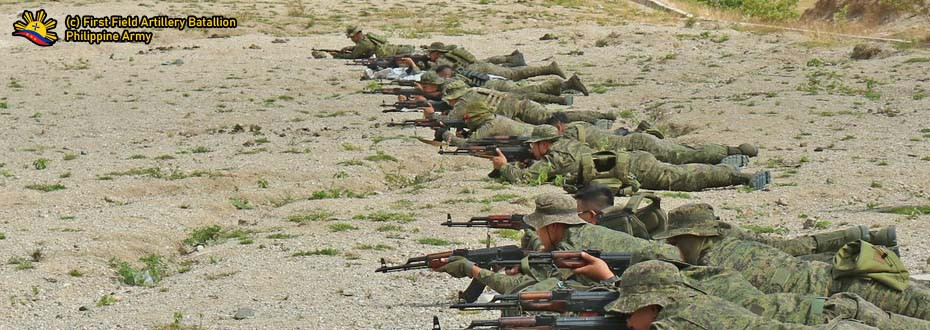OVERVIEW
 |
| M-113 in the Philippine Army Arsenal |
 |
| The same question has raised in the Defense of the Republic of the Philippines, where such questions have already debunked in Timawa. |
The M-113 Arisgator design have made out from the 1990s where the Italians purchased and gets such design. The Indonesian army is eyeing to have such amphibious craft in which accordingly will definitely help their army to deploy their infantry in swampy areas and deep rivers, somewhat an environment Indonesia have where the Philippines are also having as well.
In such case, here are the following variables where we need to answer these questions, which it provided them in the following list below:
1. Are these feasible for the AFP to get?
2. Is it ideal for the Philippine Marine Corps to have them?
3. Are there better alternatives for the PMC to have other amphibious craft other than this one, or complementary units coming onto it?
4. Is it ideal for the Philippine Army to get them since they have those large stockpiles or M-113s?
5. In connection to number four, citing Indonesian Army's interest to have them, is it good for the Philippine Army to adopt what the Indonesians are having?
 |
| The specifications of the M-113 Arisgator. Image Source. |
With the information of its origin now is given, let us return to the question which will bear variable to the discussion in which the Pitz Defense Analysis will now give its answers based on other discussion matters relating to this topic as well as the analysis given from such discussions in which it bears logic.
1. Are these feasible for the AFP to obtain? Well, the answer to that is a clear yes since the swimming kit made by an Italian company made it become less expensive to obtain, not to mention that it was really meant that way since a fully dedicated amphibious vehicle is far more expensive when compared to this one.
Now, this is where the discussion gets deeper. It is an undisputed fact that it is affordable for the AFP to attain. Now another follow-up question sets in, which is "Which branch within the AFP will be the recipient of these vehicles assuming that we have them?" To answer that question, it has already given the series of questions and mentions earlier that two branches can have them. It is the Philippine Army and the Philippine Navy's sub-branch, the Philippine Marine Corps, which may get questioned to the number two regarding the ones who are really fond of amphibious landings.
2. Is it ideal for the Philippine Marine Corps to have them? Given the technicalities and the variables at play in this organization, it is possible for them to have such vehicles. But then again, back to the question, is it ideal? The answer is a big, big.....NO.
So, why not? The M-113 are so common in the AFP where compatibility is not an issue? And these things are affordable for the marines to have? The answer to these question is indeed technical in nature that the fundamental point of saying no goes to one, very important detail, somewhat a very important point for the marine corps to consider, which is the number of troops capable for an amphibious vehicle to carry.
Say, they are the Philippine Marine Corps and they will be the recipient to have such amphibious vehicle. Now, they have this doctrine which sets the standards as to what steps, procedures and ideal numbers, carrying capacity included, have written and have implemented strictly.
3. Are there better alternatives for the PMC to have other amphibious craft other than this one, or complementary units coming unto it? The answer is yes. There is a better alternative for the PMC to have other amphibious craft. In fact, it is already in the work-in-progress wherein some accounting and production have already taken place that it is the Hanwha Techwin (Formerly Samsung Techwin) will be the ones who produce the KAAV-7 which will complement the Tarlac-class LPDs the Navy obtain which is ideal for an amphibious operation. The reason for these things pertains to the marine's doctrine which was explained in answer number two.
4. Is it ideal for the Philippine Army to obtain them since they have those large stockpiles or M-113s? Technicality-wise, considering the compatibility and the logistical advantage due to the enormous number of these armored personnel carriers in its inventory, no doubt one can say it will be ideal so unto that. Moreover, the term "amphibious" that is defined here is so different from having it traverse a swamp or a river is different than the usual ones done by the Marines such as a shore landing in which it was given earlier.
5. In connection to number four, citing Indonesian Army's interest to have them, is it good for the Philippine Army to adopt what the Indonesians are having? Well, considering the demands and requisites both forces are aiming, this kind of question cannot answered that easily because of the first and only the very reason there is to consider, which is the doctrines of each of the nations have.
CONCLUSION
 |
| Getting these KAAV-7s for the Philippine Marine Corps is the better decision rather than the M-113 Arisgator path. Got from Bemil Chosun Website. |



















































